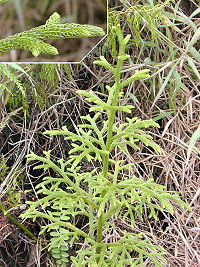Lycopodiophyta
| Lycopodiophyta Fossil range: 428 Ma Silurian to recent |
|
|---|---|
 |
|
| Lycopodiella cernua | |
| Scientific classification | |
| Kingdom: | Plantae |
| Division: | Lycopodiophyta Cronquist, Takht. & W.Zimm.[1] [P.D. Cantino & M.J. Donoghue][2] |
| Classes | |
|
Lycopodiopsida - clubmosses |
|
The Division Lycopodiophyta (sometimes called Lycophyta or Lycopods) is a tracheophyte subdivision of the Kingdom Plantae. It is the oldest extant (living) vascular plant division at around 410 million years old,[3]:99 and includes some of the most "primitive" extant species. These species reproduce by shedding spores and have macroscopic alternation of generations, although some are homosporous while others are heterosporous. Members of Lycopodiophyta bear a protostele, and the sporophyte generation is dominant. [4] They differ from all other vascular plants in having microphylls, leaves that have only a single vascular trace (vein) rather than the much more complex megaphylls found in ferns and seed plants.
Contents |
Classification
There are around 1,200[5]:8 living species divided into three main groups within the Lycopodiophyta, sometimes separated at the level of order and sometimes at the level of class. These are subdivided at the class level here:
- Class Lycopodiopsida – clubmosses and firmosses
- Class Isoetopsida – quillworts, scale trees, and spikemosses. The spikemosses are sometimes classified under Selaginellopsida.[6]
Evolution
The members of this division have a long evolutionary history, and fossils are abundant worldwide, especially in coal deposits. In fact, most known genera are extinct. The Silurian species Baragwanathia longifolia represents the earliest identifable Lycopodiophyta, while some Cooksonia seem to be related.
Fossils ascribed to the Lycopodiophyta first appear in the Silurian period, along with a number of other vascular plants. Phylogenetic analysis places them at the base of the vascular plants; they are distinguished by their microphylls and by transverse dehiscence of their sporangia (as contrasted with longitudinal in other vascular plants). Sporangia of living species are borne on the upper surfaces of microphylls (called sporophylls). In some groups, these sporophylls are clustered into strobili.
During the Carboniferous period, tree-like Lycopodiophyta (such as Lepidodendron) formed huge forests and dominated the land. Unlike modern trees, leaves grew out of the entire surface of the trunk and branches, but would fall off as the plant grew, leaving only a small cluster of leaves at the top. Their remains formed many fossil coal deposits. In Fossil Park, Glasgow, Scotland, fossilized Lycopodiophyta trees can be found in sandstone. The trees are marked with diamond-shaped scars where they once had leaves.
Characteristics
Club-mosses are homosporous, but spike-mosses and quillworts are heterosporous, with female spores larger than the male, and gametophytes forming entirely within the spore walls.
The spores of Lycopodiophyta are highly flammable and so have been used in fireworks.[7] Currently, huperzine, a chemical isolated from a Chinese clubmoss, is under investigation as a possible treatment for Alzheimer's disease.
Gallery
|
Lycopodites, an early lycopod-like fossil. |
 External mold of Lepidodendron from the Upper Carboniferous of Ohio. |
Fossil in situ lycopsid, probably Sigillaria, with attached stigmarian roots. |
 Base of a fossil lycopsid showing connection with stigmarian roots. |
References
- ↑ Cronquist, A.; A. Takhtajan, W. Zimmermann (1966). "On the higher taxa of Embryobionta". Taxon (International Association for Plant Taxonomy (IAPT)) 15 (15): 129–134. doi:10.2307/1217531. http://jstor.org/stable/1217531.
- ↑ Cantino, Philip D.; James A. Doyle, Sean W. Graham, Walter S. Judd, Richard G. Olmstead, Douglas E. Soltis, Pamela S. Soltis, & Michael J. Donoghue (2007). "Towards a phylogenetic nomenclature of Tracheophyta". Taxon 56 (3): E1–E44.
- ↑ McElwain, Jenny C.; Willis, K. G.; Willis, Kathy; McElwain, J. C. (2002). The evolution of plants. Oxford [Oxfordshire]: Oxford University Press. ISBN 0-19-850065-3.
- ↑ Eichhorn, Evert, and Raven (2005). Biology of Plants, Seventh Edition. 381-388.
- ↑ Callow, R. S.; Cook, Laurence Martin (1999). Genetic and evolutionary diversity: the sport of nature. Cheltenham: S. Thornes. ISBN 0-7487-4336-7.
- ↑ "www.ncbi.nlm.nih.gov". http://www.ncbi.nlm.nih.gov/Taxonomy/Browser/wwwtax.cgi?mode=Undef&id=3243. Retrieved 2009-03-19.
- ↑ Cobb, B (1956) A Field Guide to Ferns and their related families: Northeastern and Central North America with a section on species also found in the British Isles and Western Europe (Peterson Field Guides), 215
External links
- Introduction to the Lycophyta from the University of California Museum of Paleontology
- Lycophytes
- Fossil Groves
- Paleo Plants
|
||||||||||||||||||||||||||||||||||||||||||||||||